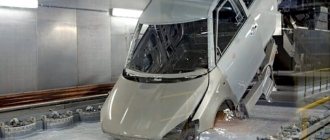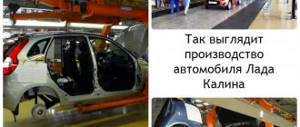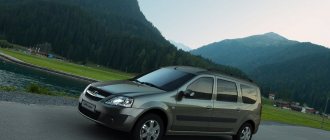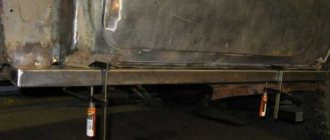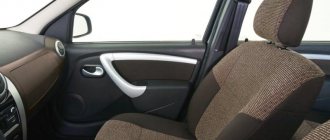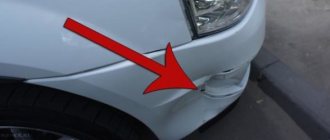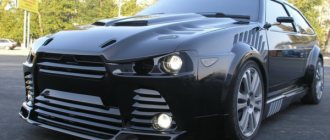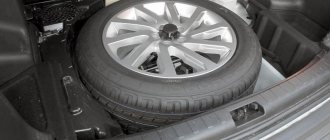Features of the Lada Largus car with a galvanized body
This car model is very similar to the Renault Logan MCV.
The only distinctive features are the modified version of the lining of its false radiator grille, as well as the Lada brand logo. The car is quite massive and has an impressive weight (about 1200 kg). The design of this model is quite strict and restrained, has quite simple outlines. The front end is equipped with standard fog lights. The body has straight side panels with a fairly wide glass area. The main feature of the Lada Largus van is galvanized body parts. As for the shape of the body itself, it is specially designed to provide large-volume internal content. We can say that this car is designed for all occasions. The body is characterized by high windage.
The Lada's interior has three rows of spacious seats. The number of seats directly depends on the configuration: there are five and seven-seat versions. The interior of the car is largely the same as the Logan MCV, which explains the interior trim with not so expensive materials. Almost every detail in the cabin speaks of a certain budget included in its development. But at the same time, nothing bad can be said about the car’s equipment: the operation of all instruments and steering is at a fairly high level. The first two rows of seats are quite comfortable and spacious; the third row has much less space.
Another feature of the van is its luggage compartment. The five-seater version of the car assumes a considerable compartment volume, which is 700 liters. And if you fold the second row, you can get a very wide trunk space of 2350 liters.
This model still has several disadvantages, according to owner reviews:
- a kind of asceticism of the car interior;
- low level of sound insulation;
- The spare tire is located at the bottom of the body, which leads to its constant contamination.
Some technical characteristics of Lada Largus
The chassis of the Lada Largus with a galvanized body has very similar features to the Renault-Dacia. The front suspension is equipped with wishbones and a stabilizer bar. The rear suspension beam consists of a suspension mounted on trailing arms, which are connected by a beam mounted on the body. In general, the car’s suspension system is quite energy-intensive, has long shock absorber strokes and rear springs with reinforced mechanisms.
The front disc brake part of the vehicle is equipped with a well-ventilated system, the rear part has a special drum mechanism. The possibility of additional installation of ABC is provided.
The engine system of the Largus station wagon involves the presence of two gasoline engines with a volume of 1.6 liters and a mechanical device equipped with five gear modes.
As for the dynamic properties, it can be noted that the car moves along the road smoothly and measuredly. On roads with poor quality surfaces, the Lada wins thanks to the excellent performance of its suspension.
Price marks for a van are in the range of 350-430 thousand rubles. They depend directly on the configuration option. There are three options for this configuration:
Overall, this car is a good budget option that is perfect for a large family. A roomy van will provide its owners with good, reliable and comfortable qualities. A high-strength body with galvanized parts will improve the level of safety.
Review of the BMW 5 Series E34
Over the entire period of its development, the BMW 5 Series has achieved great worldwide success. The high demand for them was justified by the presence of a strong body, highly reliable mechanics and a very reasonable cost. Cars in the E34 body appeared in 1988 and became an undoubted discovery of their class.
Review of the Audi 100 (series 44)
Cars produced under the Audi brand are quite popular among car enthusiasts in Russia. This fact is understandable, since these cars have a number of advantages over their competitors in the automobile market.
Review of the BMW M5 car
The luxurious BMW M5 car was introduced to the market in 2011. He immediately gained numerous fans among drivers and car enthusiasts. This is a very stylish sports car from the famous German manufacturer.
History of the development of the BMW E39
The first BMW fifth series models appeared back in 1995. They are still popular among modern car enthusiasts. Production of such cars was completed in 2003.
Review of the capabilities of the new Honda CR-V
Honda is one of the leading car manufacturers in Japan. In Russia, this company occupies a leading position in sales, delighting customers with regular innovative solutions and improved car models.
Conditions of insufficient visibility and measures to combat it together with Renault
Driving a car is an extremely complex process. There are many factors that can influence it.
Body treatment: galvanizing and other measures
Although on Largus it is not the entire body that is galvanized, but only those areas that are more exposed to an aggressive environment, in this regard it is treated much better than other AvtoVAZ models. In particular, all body panels are finished. Some parts are galvanized on both sides; there are also those that are processed on one side (for example, the roof).
The mere fact that Alliance Production Vai technology is used in the production of the Largus body speaks volumes. Of course, AvtoVAZ personnel had to retrain in terms of assembly technologies and nomenclature, but it was worth it. The same technology is used today by Nissan and Renault. It is considered the most progressive in the world, and many famous companies have already laid their eyes on it.
How does this technology differ from similar ones? First of all, this is due, of course, to the assembly method. Now it is not the technologist who is responsible for it, as before, but the master himself.
Despite the fact that the master understands the nuances of bodywork more than the technologist, he will need to delve into the essence of the assembly and conduct a detailed analysis in order to improve the process and speed it up. Only after he succeeds does he write a detailed action plan according to which the assembly begins.
Note. Thus, this allows each specialist to approach work creatively, realizing their ideas in a broader sense of the word.
The Largus welding shop at the plant was built in less than a year. Here today almost everything is done by a robot. It is extremely difficult for a person to weld in hard-to-reach areas of the body, but for robotics this does not pose any difficulty.
Note. If previously you had to pay for the expensive work of highly professional welders, today a semi-automatic welding manipulator, for which you also paid a lot, but once, will do the same thing many times and without human errors.
The human factor, indeed, interfered with the production of AvtoVAZ quite a bit. Numerous defects and errors, which remained unnoticed for the time being, negatively affected the final result. Thanks to the introduction of robotics, it was possible to immediately notice a defect if it took place.
So, the main branch of the Largus conveyor has been completely modernized, which ensures the simultaneous production of 5 cars at once (2 Ladas, 2 Renaults and 1 Nissan). Welding, assembly and painting of all these body models is carried out in one flow, which is also done for a reason. Thus, it is possible to vary production depending on current demand.
The Largus body is painted in a special workshop, the modernization of which has not yet begun. As they promise, this will happen soon. By mid-summer next year, painting of the body using nanotechnology will begin. For experimental purposes, several bodies have already been painted this way. And the result immediately struck me with the brightness of the paintwork and its durability.
Body
Body parts: 1 – left luggage compartment door; 2 – right luggage compartment door; 3 – rear bumper; 4 – right side window of the rear compartment; 5 – right rear door; 6 – front door right; 7 – hood; 8 – outside rear view mirror; 9 – right front wing; 10 – front bumper
The Lada Largus body is a one-piece welded structure. It is welded on a robotic line. All body parts that are prone to corrosion are galvanized. The main method of connecting body parts to each other is resistance welding, and electric welding is used in hard-to-reach places. All welds and joints of parts are coated with mastic. When making a body, after connecting its main parts, it is immersed in a special bath with an anti-corrosion compound. Then the primer and paint coating are applied. Hidden cavities are treated with a wax auto-preservative, and the bottom is covered with anti-corrosion mastic.
The volume of anti-corrosion mastic applied to the bottom has been increased by one and a half times compared to Renault Logan.
The body is designed taking into account the most advanced requirements for passive vehicle safety. One of the most important elements of passive safety is the front subframe, which has the property of redistributing impact energy. Car bumpers are made of impact-resistant material that absorbs impact energy. The car doors have metal stamped reinforcements in case of a side impact.
Due to the fact that the body has a very rigid structure, and the plastic interior parts have a gap between each other and are secured with special fasteners, there is virtually no vibration noise in the cabin (the so-called “crickets”).
The LADA Largus windshield is three-layer, it is glued into the body frame and is part of its load-bearing structure. All other car windows are tempered. The side door windows are sliding and, depending on the configuration, have either a manual or electric drive.
The side windows of the rear compartment can be opened slightly (7-seater version).
fixed provided for this , which is very convenient if the car is in a cramped loading/unloading space.
A modification of the car called LADA Largus Cross has unpainted black front and rear bumpers, as well as protective covers on the wheel arches and sills made of black plastic.
About choosing paint to match the body color
Theoretically, the paint can be selected according to the code that is indicated on the nameplate on the car or is stamped by the VIN code. However, very often the resulting color differs significantly from the body color. This is due to two factors: production features and the abundance of color matching systems (programs). The problem is that there is no uniform production of paint of certain shades. At automobile factories, the desired tone is obtained according to a certain recipe: a package of pigments is added to a barrel with the main color. For each batch of machines a new batch is made. And just as parts can differ from each other by a tolerance, so paints also vary slightly in shade.
At a car plant, you won’t find two barrels with a 100% color match—even cars from neighboring batches have different colors. Factory-prepared paint is not supplied to the secondary market, and during body repairs at any service center you have to select the tone. There are color matching systems for this.
About Largus in general
Lada Largus is a car that, for many experts, heralds the beginning of a new era in the domestic automobile industry. And indeed it is. This machine can become the best in the entire history of the Tolyatti conveyor. You can believe this now, although modernization is only half completed.
Not a single Russian car produced by AvtoVAZ can be compared with Largus for the owners of this car who switched to it from another domestic model. They themselves write about it in the forums. Let's take, for example, the same Renault Logan and put it next to Largus. The difference is like heaven and earth.
more about Largus from a video collection of photos
On the other hand, the interior of Largus copies the shortcomings of Logan's. Designers will have to work hard with this. This applies to the front STKP buttons located on the dashboard and between the front seats. The horn button, located on the left steering column switch, and the windshield washer, which is activated separately from the windshield wipers, are not without ergonomic shortcomings. The seat heating button also raises a lot of questions, which can only be found by touch.
But, again, with so many interior “jambs”, Largus looks stylish, solid and cozy compared to other AvtoVAZ models. Of course, those drivers who were lucky enough to experience the comfort of executive foreign cars will not be so comfortable here, but still.
Largus is also affordable. The station wagon turned out to be cheaper than the Renault Logan, also produced in our country, and in addition, inferior in capacity and dimensions. What's the catch, and is there one?
There is so much space for passengers in the Largus at the back that the engineers decided to even add half-visors above their heads. They will in no way affect the heads of people even taller than average.
As for the third row, it is not deprived of freedom for landing and travel. You definitely won’t feel any discomfort over short distances, but a long trip may be more tiring.
The Largus trunk immediately impresses with its cargo potential if you remove the rear seats. It’s a pity that in the 7-seater version only a couple of bags fit into the trunk.
As mentioned above, the rigidity of the car body is made at a high level. The suspension plays in unison with it, sharpened to perfection for Russian potholes and pits. She cracks them like seeds.
Let us remember that Largus is the brainchild of a joint development of the Togliatti plant and the Renault-Nissan concern. Launched into mass production at the beginning of 2012. The conveyor was immediately prepared for the production of 350 thousand pieces per year.
Largus has an external resemblance to Logan, except for the design of the front part. There is a slightly different radiator grille here, although the optics and other elements were inherited from Renault.
Largus belongs to the budget car segment. The model was created exclusively for the needs of the average Russian family, who may need a universal and inexpensive car.
Galvanized body or not on Lada Largus?
Car : Lada Largus. Asks : Alexander Ushakov. Question : does the Lada Largus have a galvanized body or not?
On my Largus station wagon, after the fender was scratched, the metal began to bloom for some reason. Rust appeared near the chip site. Isn't the body of the Lada Largus galvanized?
In different brochures they write one thing: all external panels are protected with zinc! It seems like it can’t even be any other way. But I couldn’t detect zinc on the metal where there was a scratch. What does it mean? I just want to find out who is deceiving whom.
Is the body of the Lada Largus galvanized: photos and videos of galvanization
Car: Lada Largus. Asked by: Alexander Ushakov. Question: Does the Lada Largus have a galvanized body or not?
On my Largus station wagon, after the fender was scratched, the metal began to bloom for some reason. Rust appeared near the chip site. Isn't the body of the Lada Largus galvanized?
In different brochures they write one thing: all external panels are protected with zinc! It seems like it can’t even be any other way. But I couldn’t detect zinc on the metal where there was a scratch. What does it mean? I just want to find out who is deceiving whom.
Lada Largus is not all galvanized, but only some body elements
The following two tabs change content below.
An expert on Lada cars with many years of experience. I own a Lada Granta car, I collect cramps based on the Priora. Sometimes I stay overnight in the garage. My wife is more jealous of cars than of women.
All possibilities for applying galvanization at AvtoVAZ come down to two: buy galvanized steel or apply zinc using the “cold” method. In the second case, the coating is applied from a spray bottle. The galvanic method is not used at AvtoVAZ, and even more so, the enterprise does not have baths with molten zinc.
All Largus family cars have the following parts galvanized on both sides:
- front wings,
- roof,
- external door panels,
- hood.
Proof of the galvanization of these body parts by the factory is shown in the photo.
The roof, or rather, many roofs
Left rear door (outer panel)
Doors for station wagon body
Are the thresholds galvanized?
The thresholds are also galvanized on the outside, and each seam remaining after welding is treated in the same way. Although the bottom is not galvanized, it is treated with a primer. And it, in turn, is applied using the galvanic method.
Why is it this way?
All parts with double-sided galvanization were listed above. Perhaps they are made from finished galvanized steel. By the way, the rear wing is not on the list. Well, thresholds, as well as welds, are always processed separately. Here VAZ uses the “cold” method (see photo).
This is how steel is cold galvanized.
Almost the entire outer surface remains protected as a result. Now think about what the dealer should say when they ask him: “Is the body of the Lada Largus really galvanized?” The answer “yes” will not be wrong, and certainly not a deception.
Be that as it may, cataphoretic soil is also a good protection, which VAZ uses to the fullest. But for some reason new cars from Korea and Japan now come without primer. Maybe manufacturers are saving money, or they have found a “magic” way to protect parts from corrosion.
Where does the VAZ get galvanized metal from - details in the video
carfrance.ru
Lada Largus is not all galvanized, but only some body elements
All Largus family cars have the following parts galvanized on both sides:
- front wings,
- roof,
- external door panels,
- hood.
Proof of the galvanization of these body parts by the factory is shown in the photo.
Are the thresholds galvanized?
The thresholds are also galvanized on the outside, and each seam remaining after welding is treated in the same way. Although the bottom is not galvanized, it is treated with a primer. And it, in turn, is applied using the galvanic method.
Is the LADA body galvanized or not?
AVTOVAZ has published another video from the “Good Mechanics” series. In this episode, presenter Stas talks about the thickness of the metal body of Vesta and XRAY, as well as the anti-corrosion treatment of AvtoVAZ’s new products. At the end, they answer the question of whether additional body protection is needed for these models.
So, is the Lada body galvanized or not? On the latest Lada models (Vesta and XRAY), external body panels are galvanized. Internal cavities that are not exposed to the external environment are not galvanized. To protect against corrosion they are treated with catapharesis primer.
In addition, Lada Vesta and XRAY use a new anti-corrosive agent, which spreads best over the surface, into all the cracks of the body and best protects the body. Massive use of zinc began on Lada Kalina cars.
External body panels of modern Lada models (VESTA and XRAY) are protected from corrosion by several layers that are applied to the metal of the body (its thickness is 0.6-0.8 mm): - Zinc; — Catapharesis soil (primary); — Catapharesis primer (secondary, polyester); — Base layer of enamel; - Varnish.
Anti-noise mastic is additionally applied to the bottom of the car or the weld between the layers of catapharesic primer.
The modern Lada car body is covered with a two-component primer, which can withstand about 1,500 hours in salt fog (in 1970, the Lada body could withstand only 96 hours). As an example of corrosion resistance, the Vesta hood was demonstrated, on which a calibrated cut was made. After which the body was in the salty fog for many hours, which is equivalent to 4 years of operation of the car. As a result, zinc successfully protected Vesta’s hood from rust. The presenter also showed the internal cavities of the body, which also successfully passed the test. No rust or corrosion was found.
Galvanized hood of LADA VESTA after salt fog
Next, a stand was demonstrated (a shot blasting machine emits a trip along the highway when stones and sand fall on the car body) to check the quality of the paintwork (paint and varnish coating). How the quality of primer, enamel and varnish evolves was shown with an example. We compared the paintwork of VAZ 2110, Priora, Kalina, Niva 4x4 and XRAY. You can see the test results in the photo:
Do Vesta or XRAY need additional anti-corrosion protection? The standard protective complex is sufficient to protect the body from corrosion during average vehicle use. It only makes sense to use additional anticorrosion protection (2 years after purchase) if you intend to use the car for 8-10 years.
Summary. Today's Lada body is a modern high-tech product, quite protected and always ready for use in our harsh road and climatic conditions.
photo, original article published on Lada.Online
Watch the video:
Why is it this way?
All parts with double-sided galvanization were listed above. Perhaps they are made from finished galvanized steel. By the way, the rear wing is not on the list. Well, thresholds, as well as welds, are always processed separately. Here VAZ uses the “cold” method ( see photo ).
This is how steel is cold galvanized.
Almost the entire outer surface remains protected as a result. Now think about what the dealer should say when they ask him: “Is the body of the Lada Largus really galvanized?” The answer “yes” will not be wrong, and certainly not a deception.
Be that as it may, cataphoretic soil is also a good protection, which VAZ uses to the fullest. But for some reason new cars from Korea and Japan now come without primer. Maybe manufacturers are saving money, or they have found a “magic” way to protect parts from corrosion.
Popular Russian cars with galvanized bodies: list
The list of Russian-made cars with a body coated with a layer of zinc is not rich. Of the manufacturers, only the Volzhsky Automobile Plant (VAZ) and the automaker from Ulyanovsk (UAZ) are engaged in this. To reduce the cost, some models are only partially galvanized, i.e., only individual parts are protected. For complete treatment, inexpensive cataphoretic priming of the body with the addition of zinc particles is used. The protection is effective, but cannot protect the metal for more than 5 years. Moreover, one-sided galvanizing is used, when only the outer side is processed, the inner side is primed and painted.
VAZ 2110
The first VAZ model with partial anti-corrosion treatment using zinc
In the 10th family, body corrosion protection by cold galvanizing began to be used in 1999. Nodal connections, i.e., places of welding seams, fastenings and other elements, were subjected to processing. Corrosion of the body began quickly, because there was practically no metal protection.
Lada Kalina 1st generation
The first generation of Kalina family station wagons
The first Kalinas were partially galvanized, the total percentage of treated surfaces is about 50%. These include all attached parts (doors, trunk lid and hood), underbody and front wheel arches.
Lada Kalina 2nd generation
The second generation of the Kalina family in the hatchback body
The first releases of Kalina 2 did not differ in galvanized area from the first “berry” VAZ family. Later models have a completely galvanized body; the side members at the front and rear, the roof and the hood were left untreated. It is worth considering that the chosen processing method does not provide a 100% guarantee of protection against corrosion.
Lada Largus
New model Lada Largus with cladding from Vesta
The Renault Logan clone in a station wagon from VAZ is also only partially galvanized. The front fenders, sills, trunk lid and doors have been treated.
Lada Granta
Granta sedan, car with high-quality galvanization
The Lada Granta sedan is 30% made of galvanized steel. In this case, part of the metal is additionally treated with hot zinc on both sides. The Granta in the liftback body is additionally protected from the bottom.
Lada Vesta
VAZ flagship with galvanized body
The flagship of the Russian automobile industry became the first VAZ car with a double-sided galvanized body, with the exception of the roof of the sedan (the station wagon was completely treated). The bottom and sills are without zinc protection.
Lada X-ray
X-ray crossover based on Vesta
The crossover from AvtoVAZ is galvanized on both sides, only the roof and bottom are not treated.
Domestic SUV UAZ Patriot with the best galvanization
At the Ulyanovsk Automobile Plant, UAZ Patriot cars produced since 2013 were subjected to partial cold galvanization. Since 2014, the Patriot has been processed using the galvanic method (the body is completely immersed in a zinc bath), which provides excellent protection against corrosion.
All models without exception use cold galvanizing and cataphoretic priming, which allows us to provide a guarantee of up to 6 years. Technologies are improving every day, the thickness of the protective coating is increasing. So far, the most protected car from rust is the UAZ Patriot (among domestic manufacturers), but AvtoVAZ is not far behind.
Where does the VAZ get galvanized metal from - details in the video
I think that galvanizing technology is still present at the plant. But because of the famous Russian carelessness, anything can happen...
if you cover it with zinc even on both sides it will not become stainless steel
Then zinc will definitely not help you
after the car lady “parked” in the back, I was surprised to discover the complete absence of any signs of “zinc” on the exposed pure metal of the doors and floor from under the peeling paintwork... Apparently they are making a “classic budget” version for the Russian market
This is the same situation only the Armenians had)) the paint has peeled off but the body has not bloomed for 7 months already, I think the doors are closing)) depends on the configuration, it’s probably absurd of course, but this is Togliatti, needless to say, and the night shift))
I had an accident, the car is white, the paint on the threshold has been torn off, there is no zinc or primer under the paint layer, three days later the entire threshold is rusty
At our enterprise we have a working car LARGUS, so in November a scribe on a four-wheel drive drove into it and took off... now it’s March 22 and we’ve been driving the LARGUS all this time and for the last 2 months it’s been parked... (EXCLUSIVELY ON THE STREET there is no garage) the paint is in place blows to the rear fender, it was cast right down to the metal... and you can immediately see from the color and whitish stains of oxides that this is galvanized and naturally no rust has appeared on the metal over these months (the car drives on a stand and therefore no one repairs it) the only place where it is very strong the rust is visible when you open the gas tank flap (apparently they saved it with Gulkin H.Y.) there is a knot from a regular rental...
This is the second year I’ve been driving with Kotska to the metal on the rear left fender (the Niva shuffled). I didn’t touch up the paint because... Kotska from 1 rub does not rust and does not bloom, gray zinc is visible. Largus from the beginning of production in 12 and up to 14 inclusive were assembled from Kazakhstan steel. Afterwards, they began to sculpt from our G, from which they had previously sculpted Kalinas, Priors, Grants, etc.
Features of the Lada Largus car with a galvanized body
This car model is very similar to the Renault Logan MCV. The only distinctive features are the modified version of the lining of its false radiator grille, as well as the Lada brand logo. The car is quite massive and has an impressive weight (about 1200 kg).
The design of this model is quite strict and restrained, has quite simple outlines. The front end is equipped with standard fog lights. The body has straight side panels with a fairly wide glass area. The main feature of the Lada Largus van is galvanized body parts. As for the shape of the body itself, it is specially designed to provide large-volume internal content. We can say that this car is designed for all occasions. The body is characterized by high windage.
The Lada's interior has three rows of spacious seats. The number of seats directly depends on the configuration: there are five and seven-seat versions. The interior of the car is largely the same as the Logan MCV, which explains the interior trim with not so expensive materials. Almost every detail in the cabin speaks of a certain budget included in its development. But at the same time, nothing bad can be said about the car’s equipment: the operation of all instruments and steering is at a fairly high level. The first two rows of seats are quite comfortable and spacious; the third row has much less space.
Another feature of the van is its luggage compartment. The five-seater version of the car assumes a considerable compartment volume, which is 700 liters. And if you fold the second row, you can get a very wide trunk space of 2350 liters.
This model still has several disadvantages, according to owner reviews:
- a kind of asceticism of the car interior;
- low level of sound insulation;
- The spare tire is located at the bottom of the body, which leads to its constant contamination.
Features of factory galvanization of body parts of Kalina-2 - a new VAZ model
The area of galvanized body parts of Kalina-2 remained the same as in the previous berry family, namely, about 38%. What exactly should be galvanized - the choice was made according to accumulated experience; first of all, of course, the lower parts of the body remain treated. 1-double-sided, 2-sided galvanizing in Volkswagen vehicles
If a certain metal panel, external or internal, has been galvanized, the non-ferrous metal coating can only be seen from the inside. But this is not cost savings. A primer is applied to the outside, which prevents scratches, protects against corrosion, etc. This “nuance” is clearly indicated in the car’s service book: if there are scratches, check whether the metal is damaged (if so, touch up). The main purpose of galvanizing is that the car should not rust “unnoticed” by the owner (when there seems to be no obvious damage).
Applying paint and primer over galvanizing is a technology completely different from standard painting. Double-sided galvanized steel is used for the manufacture of fasteners and elements subject to significant corrosion. The use of galvanizing on one side is a common option used in the automotive industry.
kalina-2.ru
Some technical characteristics of Lada Largus
The chassis of the Lada Largus with a galvanized body has very similar features to the Renault-Dacia. The front suspension is equipped with wishbones and a stabilizer bar. The rear suspension beam consists of a suspension mounted on trailing arms, which are connected by a beam mounted on the body. In general, the car’s suspension system is quite energy-intensive, has long shock absorber strokes and rear springs with reinforced mechanisms.
The front disc brake part of the vehicle is equipped with a well-ventilated system, the rear part has a special drum mechanism. The possibility of additional installation of ABC is provided.
The engine system of the Largus station wagon involves the presence of two gasoline engines with a volume of 1.6 liters and a mechanical device equipped with five gear modes.
As for the dynamic properties, it can be noted that the car moves along the road smoothly and measuredly. On roads with poor quality surfaces, the Lada wins thanks to the excellent performance of its suspension.
Price marks for a van are in the range of 350-430 thousand rubles. They depend directly on the configuration option. There are three options for this configuration:
Overall, this car is a good budget option that is perfect for a large family. A roomy van will provide its owners with good, reliable and comfortable qualities. A high-strength body with galvanized parts will improve the level of safety.
Review of the BMW 5 Series E34
Over the entire period of its development, the BMW 5 Series has achieved great worldwide success. The high demand for them was justified by the presence of a strong body, highly reliable mechanics and a very reasonable cost. Cars in the E34 body appeared in 1988 and became an undoubted discovery of their class.
Review of the Audi 100 (series 44)
Cars produced under the Audi brand are quite popular among car enthusiasts in Russia. This fact is understandable, since these cars have a number of advantages over their competitors in the automobile market.
Review of the BMW M5 car
The luxurious BMW M5 car was introduced to the market in 2011. He immediately gained numerous fans among drivers and car enthusiasts. This is a very stylish sports car from the famous German manufacturer.
History of the development of the BMW E39
The first BMW fifth series models appeared back in 1995. They are still popular among modern car enthusiasts. Production of such cars was completed in 2003.
Review of the capabilities of the new Honda CR-V
Honda is one of the leading car manufacturers in Japan. In Russia, this company occupies a leading position in sales, delighting customers with regular innovative solutions and improved car models.
Conditions of insufficient visibility and measures to combat it together with Renault
Driving a car is an extremely complex process. There are many factors that can influence it.
